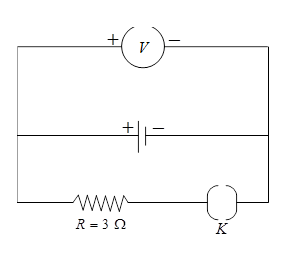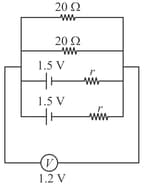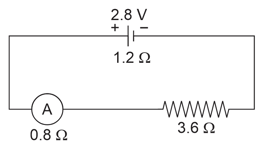EMF, Terminal Voltage and Resistance of a Cell
EMF, Terminal Voltage and Resistance of a Cell: Overview
This topic will explain the meaning of the electromotive force, terminal voltage and the internal resistance of a cell. It also mentions the differences between the EMF and internal resistance and factor affecting the terminal voltage of a cell.
Important Questions on EMF, Terminal Voltage and Resistance of a Cell
On which of the following factors internal resistance of a cell depends:
The reading on a high resistance voltmeter, when a cell is connected across it, is . When the terminals of the cell are also connected to a resistance of as shown in the circuit, the voltmeter reading drops to . The internal resistance of the cell is :

Two identical cells each of emf Volts are connected in parallel and the combination is connected across a resistor of resistance . An ammeter connected between the resistor and the cell combination gives the reading of Amperes. The internal resistance of each cell is
Five cells each of emf and internal resistance are connected in series. Due to oversight one cell is connected wrongly. The equivalent internal resistance of the combination is
A current of flows through a resistor when connected across a battery. The same battery supplied a current of when connected across a resistor. The internal resistance of the battery is
Two sources of equal emfs are connected in series. This combination is connected to an external resistance . The internal resistances of the two sources are and . If the potential difference across the source of internal resistance is zero then the value of will be
For the circuit shown in figure, if voltmeter reads , then find the value of

Two identical cells each of emf are connected in parallel across a parallel combination of two resistors each of resistance . A voltmeter connected in the circuit measures . The internal resistance of each cell is :
If a cell of constant E.M.F. produces the same amount of the heat during the same time in two independent resistors and , when they are separately connected across the terminals of the cell, one after the another, find the internal resistance of the cell.
The potential difference across the terminals of a battery is when there is a current of in the circuit form the negative to the positive terminal. When the current is in the reverse direction, the potential difference becomes The the emf of the battery is .
The potential difference across the terminals of a battery is when there is a current of in the circuit form the negative to the positive terminal. When the current is in the reverse direction, the potential difference becomes The the emf of the battery is _____ .
The potential difference across the terminals of a battery is when there is a current of in the circuit from the negative to the positive terminal. When the current is in the reverse direction, the potential difference becomes What is the emf of the battery?
It is due to the presence of internal resistance, the power delivered to the circuit is not equal to the power rating.
How is the internal resistance of a circuit measured?
A cell of emf and internal resistance is connected in series with an external resistance then the ratio of the terminal potential difference to emf is:
The internal resistance of a cell is the resistance of
What is the potential difference across the terminals of the cell in the given circuit?

What is the internal resistance of the cell if the e.m.f. of the cell is and the terminal potential of the cell is when a resistance is connected?
Assertion: In a simple battery circuit, the point at the lowest potential is the positive terminal of the battery.
Reason: The current flows towards the point of the lowest potential, as it does in such a circuit from the negative to the positive terminal.
Assertion: In a simple battery circuit the point at the lowest potential is positive terminal of the battery.
Reason: The current flows towards the point of the lowest potential, as it does in such a circuit from negative to the positive terminal.
